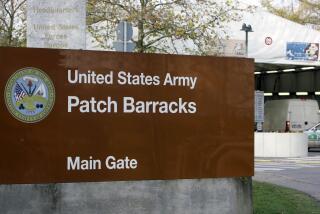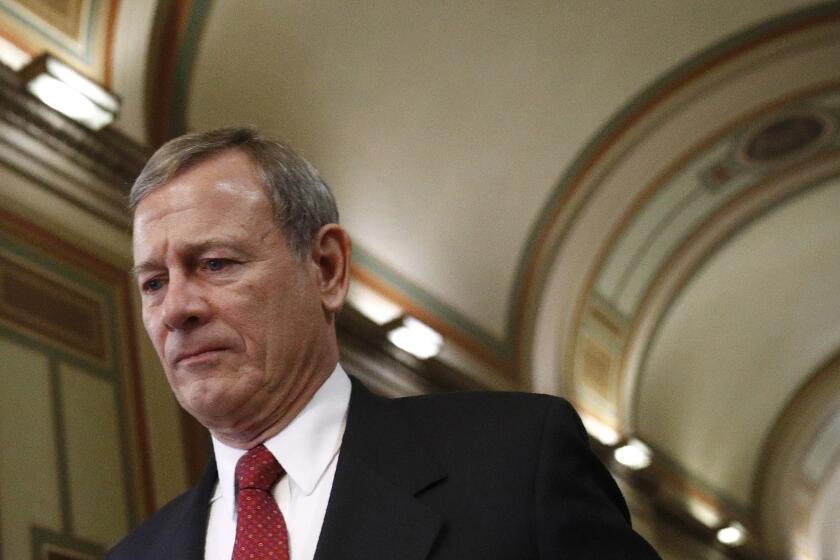Terrorist Threat Level Declines as War Winds Down
- Share via
WASHINGTON — With the major fighting in Iraq winding down, the Bush administration on Wednesday said the chances of a terrorist attack had declined, triggering a scaling back of heightened security measures adopted on the eve of war last month.
Homeland Security Secretary Tom Ridge lowered the national terrorism threat level to code yellow, indicating that the country remains at an “elevated risk” of terrorist attack. Federal authorities declared a code orange alert -- signaling a “high risk” of attack -- on March 17 as the administration was issuing its final ultimatum to Saddam Hussein to step down or face war.
At the time, intelligence officials feared that the onset of hostilities would trigger reprisals against U.S. interests. On Wednesday, Ridge acknowledged that those concerns persist but indicated the threat posed to the country had subsided somewhat.
“While we continue to be at risk to the threat of terrorism at an elevated level, extensive protective measures remain in place throughout our nation,” Ridge said in a prepared statement, adding that the easing followed a review of intelligence information in conjunction with officials from the CIA and FBI.
He added: “We must be vigilant and alert to the possibility that Al Qaeda and those sympathetic to their cause, as well as former Iraqi-regime state agents and affiliated organizations, may attempt to conduct attacks against the U.S. or our interests abroad.”
Elaborating, a homeland security spokesman added that code yellow -- the middle of the five-tier scale -- suggests a more “robust” level of preparedness than a year ago, because of additional security measures that state and local governments have since implemented.
The relaxing of the threat level comes as Bush and military commanders in the field have declared the heavy lifting in Iraq to be complete.
But the decision also comes at a time of growing unrest in the region and frustration with the U.S. approach to the war.
Administration officials this week found themselves locked in a verbal war with Syria over allegations that it was developing chemical weapons and harboring Hussein loyalists. Hard-liners in Iran have grown increasingly anxious about the possibility of an American-led transitional government in Iraq.
Monday’s capture by U.S. troops outside Baghdad of Abul Abbas, the Palestinian guerrilla leader who masterminded the 1985 hijacking of the Italian cruise ship Achille Lauro, is another potential flash point.
In addition, the FBI has come up dry so far in its efforts to locate a Saudi man who was the target of a worldwide manhunt that it launched a few days after the terror level was raised. The suspect, Adnan El Shukrijumah, who carries passports from Guyana and Trinidad and uses a half-dozen aliases, was said to be plotting terrorist attacks against the U.S. and posed an imminent threat.
With the move to yellow, homeland security officials said they would scale back Operation Liberty Shield, a series of beefed-up safety measures that ranged from having the National Guard patrol selected bridges to more detailed food inspections by the Agriculture Department.
Under the program, the FBI has also been interviewing some 11,000 Iraqi-born U.S. residents, in a “voluntary” effort to obtain information that might be useful to U.S. troops.
The tab for the extra security continues to be contentious, particularly among cash-strapped cities facing enormous overtime bills for “first responders,” such as police and firefighters. On Wednesday, the president signed legislation that allocated $4.31 billion to help pay for the “Liberty Shield” defense program, including about $2.2 billion for state and local governments. Homeland security officials said they don’t yet know what the final cost of the program will be.
The change in alert status in March marked the third time the administration had boosted the warning level to orange since the color-coded system was introduced last year. It has never been lower than yellow.
More to Read
Sign up for Essential California
The most important California stories and recommendations in your inbox every morning.
You may occasionally receive promotional content from the Los Angeles Times.










